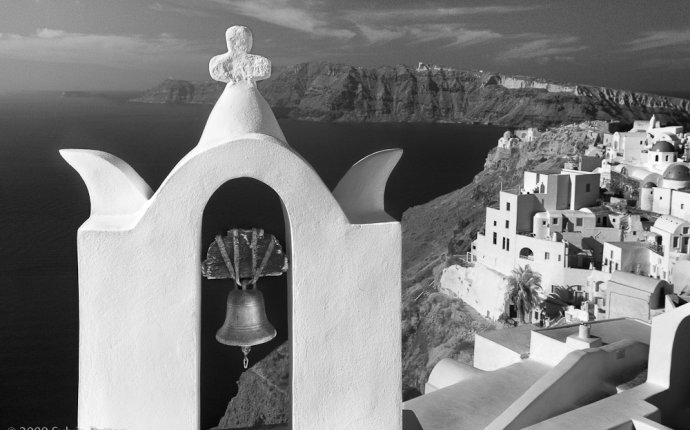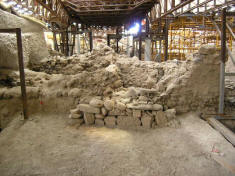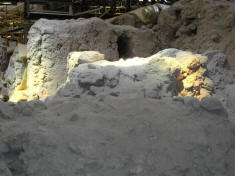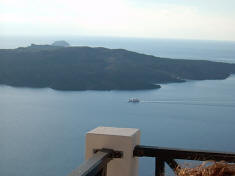
Thira Island Greece
 Santorini is the an island of a complex of islands called Cyclades (seen on the right).
Santorini is the an island of a complex of islands called Cyclades (seen on the right).
Santorini is a small, circular group of volcanic islands located in the Aegean Sea, about 200 km south-east from the mainland of Greece (latitude: 36.40N - longitude: 25.40E). It is also known by the name of the largest island in the archipelago, Thira or Thera. It is the southernmost member of the Cyclades group of islands, with an area of approximately 73 km2 (28 sq mi), and in 2001 had an estimated population of 13, 600. The inhabitants are citizens of Greece and speak Greek.
It is the most active volcanic centre in the Aegean Arc, though what remains today is largely a caldera. The name Santorini was given to it by the Venetians in the 13th century and is a reference to Saint Irene. Before then it was called Kallisti, Strongili or
Santorini - Thira.
The island was the site of one of the largest volcanic eruptions of the last several thousand years when it erupted cataclysmically about 3, 500 years ago. The eruption left a large caldera surrounded by ash deposits hundreds of feet deep, and its effects may have indirectly led to the collapse of the Minoan civilization on the island of Crete, 70 km to the south.
 Excavations starting in 1967 at the site called Akrotiri under the late Prof. Spyridon Marinatos have made Thera the best-known "Minoan" site outside of Crete, the homeland of the culture. The island was not called Thera at the time. Only the southern tip of a large town has been uncovered, yet it has revealed complexes of multi-level buildings, streets and squares, with remains of walls standing as high as 8 meters, all entombed in the solidified ash of the famous eruption of Thera. The site was not a palace-complex such as are found in Crete, but its excellent masonry and fine wall-paintings show that this was no conglomeration of merchants' warehousing either. A loom-workshop suggests organized textile weaving for export.
Excavations starting in 1967 at the site called Akrotiri under the late Prof. Spyridon Marinatos have made Thera the best-known "Minoan" site outside of Crete, the homeland of the culture. The island was not called Thera at the time. Only the southern tip of a large town has been uncovered, yet it has revealed complexes of multi-level buildings, streets and squares, with remains of walls standing as high as 8 meters, all entombed in the solidified ash of the famous eruption of Thera. The site was not a palace-complex such as are found in Crete, but its excellent masonry and fine wall-paintings show that this was no conglomeration of merchants' warehousing either. A loom-workshop suggests organized textile weaving for export.
The oldest signs of human settlement are Late Neolithic (4th millennium BC or earlier), but ca 20001650 BC Akrotiri developed into one of the Aegean's major Bronze Age ports, with recovered objects that had come not just from Crete but also from Anatolia, Cyprus, Syria and Egypt, from the Dodecanese and the Greek mainland.
Pipes with running water and water closets found on Thera are the oldest such utilities discovered. The pipes run in twin systems, indicating that the Therans used both hot and cold water supplies. The hot water's origin was probably geothermic, given the volcano's proximity.
 Fragmentary wall-paintings at Akrotiri lack the insistent mythological content familiar in both Greek and Christian decor. Instead, the Minoan frescoes depict "Saffron-Gatherers", who offer their crocus-stamens to a seated lady, perhaps a goddess; in another house two antelopes, painted with a kind of confident, flowing decorative, calligraphic line; the famous fresco of a fisherman with his double strings of fish strung by their gills; the flotilla of pleasure boats, accompanied by leaping dolphins, where ladies take their ease in the shade of light canopies.
Fragmentary wall-paintings at Akrotiri lack the insistent mythological content familiar in both Greek and Christian decor. Instead, the Minoan frescoes depict "Saffron-Gatherers", who offer their crocus-stamens to a seated lady, perhaps a goddess; in another house two antelopes, painted with a kind of confident, flowing decorative, calligraphic line; the famous fresco of a fisherman with his double strings of fish strung by their gills; the flotilla of pleasure boats, accompanied by leaping dolphins, where ladies take their ease in the shade of light canopies.
The devastating volcanic eruption of Thira has become the most famous single event in the Aegean before the fall of Troy. The eruption would have caused a significant climate upset for the eastern Mediterranean region. It was one of the biggest volcanic eruptions on Earth in the last few thousand years.
Santorini - Physical effects of the eruption
The violent eruption was centred on a small island just north of the existing island of Nea Kameni in the centre of the caldera. The caldera itself was formed several hundred thousand years ago by collapse of the centre of a circular island caused by the emptying of the magma chamber during an eruption. It has been filled several times by ignimbrite since then and the process repeated, most recently 21, 000 years ago. The northern part of the caldera was refilled by the volcano and then collapsed again during the Minoan eruption. Before the Minoan eruption, the caldera formed a nearly continuous ring with the only entrance between the tiny island of Aspronisi and Thera. The eruption destroyed the sections of the ring between Aspronisi and Therasia, and between Therasia and Thera, creating two new channels.
On Santorini, there is a deposit of white tephra thrown from the eruption; it is up to 60 metres thick overlying the soil marking the ground level before the eruption. The layer is divided into three fairly distinct bands indicating different phases of the eruption.
A series of warning earthquakes must have been alarming enough and early enough before the eruption for all the residents to pack up and move out, as not a single body has been found at the Akrotiri site, and only one body has been found on Therasia. Differences in pottery styles between the beginning of the evacuation and the catastrophic eruption, and preserved gullies eroded in the ash layers indicate that the volcano may have given warning years in advance. It remains to be seen if further excavations will show bodies of people huddled along the coast, too late to get off in a boat to escape the volcano's fury, akin to the finds at Herculaneum, which was buried by the much smaller eruption of Mount Vesuvius in 79 AD.